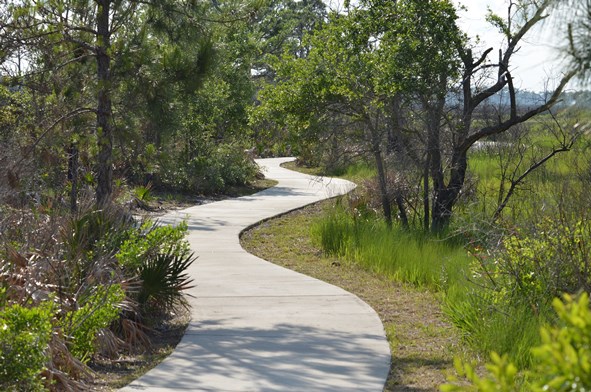
by Les Harrison | Jan 8, 2017
Some of the most picturesque and scenic natural areas along north Florida’s Gulf Coast are found in Bald Point State Park. The 4,065 acre park is located on Alligator Point, where Ochlockonee Bay meets Apalachee Bay.
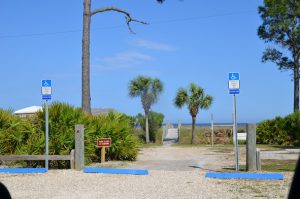
Easy access to water activities at Bald Point State Park.
Photo: Les Harrison
Bald Point State Park offers a variety of land and water activities. Coastal marshes, pine flatwoods, and oak thickets foster a diversity of biological communities which make the park a popular destination for birding and wildlife viewing.
These include shorebirds along the beach, warblers in the maritime oak hammocks, wading birds, and birds of prey in and around the marsh areas. The boardwalk and observation deck overlook the marsh near the beach.
During autumn bald eagles and other migrating raptors, along with monarch butterflies are frequently viewed heading south to a warmer winter.
Bald Point offers access to two Apalachee Bay beaches for water sports and leisure activities, and these facilities include a fishing dock and picnic pavilions at Sunrise beach, North End beach and Maritime Hammock beach. Grills and restrooms are also available, but pets are prohibited on the beach.
Pre-Columbian pottery helped archaeologists identify the park’s oldest site, placing the earliest human activity 4,000 years ago. These early inhabitants hunted, fished, collected clams and oysters, and lived in relatively permanent settlements provided by the abundant resources of the coast and forests.
In the mid-1800s and late 1900s, fishermen established seineyards at Bald Point. These usually primitive campsites included racks to hang, dry and repair nets. Evidence of the 19th to 20th century turpentine industry is visible on larger pine trees cut with obvious scars.
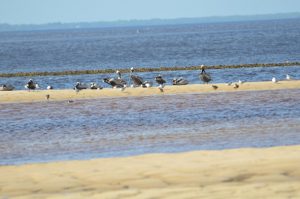
Bald Point is an excellent location for both wildlife viewing and birding.
Photo: Les Harrison
Among the varieties of saltwater fish found in the brackish tidal waterway are redfish, trout, flounder and mackerel.
Today’s visitors may fish on the bridge over tidal Chaires Creek off of Range Road, and in Tucker Lake, by canoe or kayak. Sea trout, red fish, flounder and sheepshead are common catches, and this is an excellent area to cast net for mullet or to catch blue crabs.
Bald Point State Park is open 8:00 a.m. to sunset daily, with a charge $4.00 per car with up to eight people, or $2.00 per pedestrian or bicycle
More information is available at the Florida State Park site.
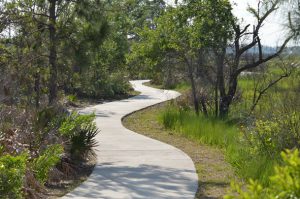
There are numerous trails where the visitor and explore Florida.
Photo: Les Harrison.
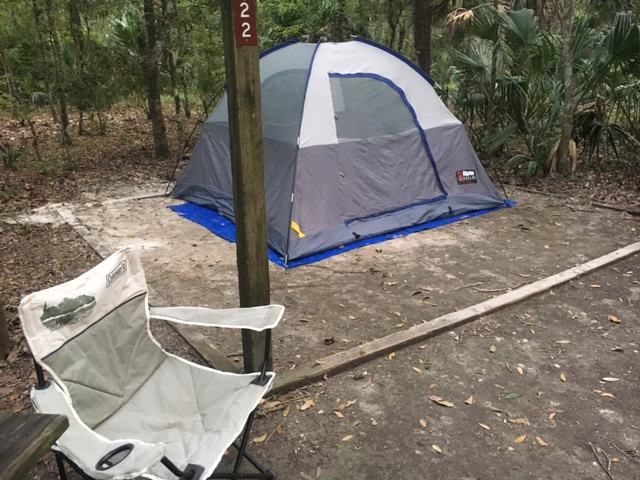
by Rick O'Connor | Sep 16, 2016
This past week I was camping at a state park near Gainesville. Working on a variety of computer related items while sitting in my chair, I was acutely attuned to the sounds of life around me. A small “pat-pat-pat” could be heard in the leaf litter around the tent. Curious as to what was making the sound, I moved the leaves until numerous small frogs showed themselves – and immediately settled on my tent. The wind rustling through the trees, the distinct “kee kee kee” of the red shouldered hawk, and the sounds of numerous woodland song birds filled the senses and all caused me to pause my work and listen to life.
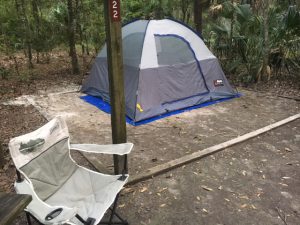
Camping is a great way to clear the mind, think through problems, and experience the natural world.
Photo: RIck O’Connor
The evenings were no different… the loud rustling of digging armadillos, the distinct calls of at least two types of owls, and the howling of coyotes could be heard every night. Then one evening…nothing… it all stopped. I heard no owls, coyotes, or frogs. The woods had become completely silent. Funny how you notice silence as much as you do the “calls of the wild”.
The following morning the skies were different. They were not dark but you could sense rain was in the area. I moved into the tent in time for the rain to begin…a light rain, but rain none the less. And it rained all day… and most of the night. I was dry within my tent – continued to work on my computer – but was aware of the extent of the rain and of the silence around me. It was not until later that evening that I heard there was a tropical system on the Atlantic coast. The woods had become silent the afternoon before…did they know it was coming?
Camping does this… it reconnects us to the natural world. We can experience Florida the way our ancestors would have. To listen to the animal sounds, sense the changes in the weather, and explore. Yes, explore. You can only sit at the campsite for so long. Most campgrounds provide hiking trails and swimming areas where you can not only explore nature but get much needed exercise. Some campgrounds provide elevated observation towers with benches where you can sit, listen, look, and let the hub-bub of typical daily life escape you for a while. Honestly… here I get some of my best ideas for work. I think clearer and can prioritize a hectic schedule of “to-do’s”. I recommend bringing a small notebook to jot down ideas as they come. It is very relaxing and productive at the same time.
If you have kids… perfect! There are fewer “wild areas” within neighborhoods for kids to explore their natural world. Many youth today have not experienced finding hermit crabs or frogs. Camping is a great way for them to do this. I understand that some are nervous about different forms of wildlife while camping (snakes) but honestly, I rarely see them. They have learned to stay clear of open areas – I have bigger problems with squirrels and ants. Do not let that stop you from enjoying Florida.
There are several state parks with camp grounds in the Florida Panhandle; Torreya State Park even has a couple of yurts! You may need to reserve a site. There are campgrounds scattered in the Apalachicola National Forest, which are less visited. If you are in the Escambia / Santa Rosa area – you can visit Naturally EscaRosa.com to find camping options in that area.
So let’s chill a bit… and go camping!
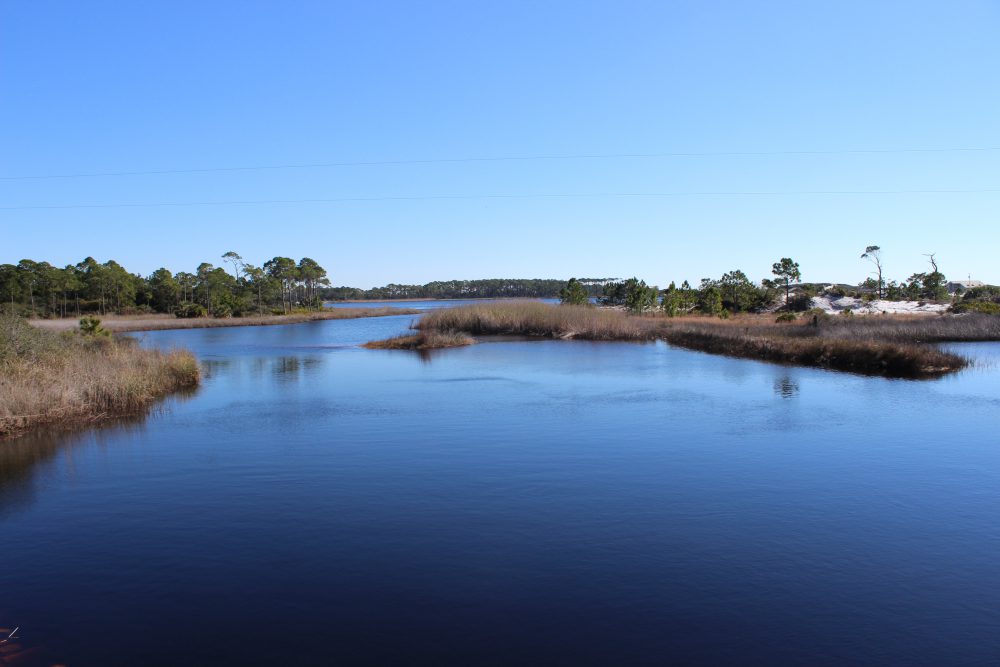
by Rick O'Connor | Jun 17, 2016
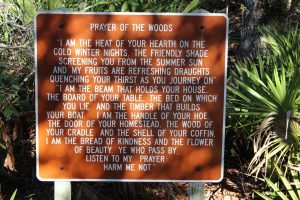
The “Prayer of the Woods” is an attitude that many in this part of the panhandle try to live.
Photos: Molly O’Connor
30A in south Walton County is a special place.
Undiscovered for years, then developed… but developed more sustainably than most coastal panhandle communities – this area has now become a go-to destination for many in the southeastern U.S. Grayton Beach, Seaside, Water Color, and others were developed with idea of walkable-biking community and allowing as much nature to remain as possible. Many subdivisions use native plants for their landscaping. It is a neat area to explore.
My base camp for this part of our ICW tour was Topsail State Park. Though there are numerous other locations to camp, they were all full… the 30A Song Writers Festival was going on at the time. The first thing I noticed was a bike trail that extends much of 30A itself. There were locations along the way where visitors can rent bicycles and it is a great way to take in the scenery… and there is scenery. Some of the more majestic dunes I have seen anywhere along the panhandle are found here. Dunes in Pensacola use to look like these but storms have taken their toll – somehow the dunes of 30A were spared.
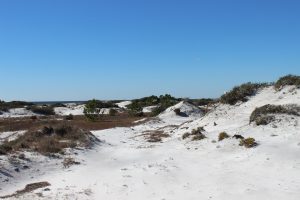
The spectacular dunes of south Walton County.
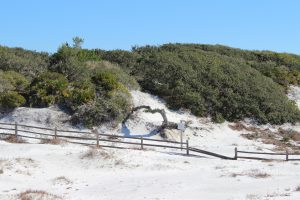
The wind sculpted plants of the tertiary dunes.
You cannot talk about the dunes without talking about the dune lakes. Scattered across much of the panhandle the highest concentration, and least impacted, of these lakes are found here in Walton County. These freshwater lakes are separated from the high saline Gulf of Mexico by a field of dunes. There are channels that connect them but these are sometimes closed by moving sand. When open, these channels allow the brown tannic waters of the lakes to spill into the Gulf – a weird sight which trigger thoughts of pollution. You can see evidence of high tides entering the lakes with the presence of cordgrass and needlerush (classic salt marsh plants) and species of marine fish such as stingray and redfish. There is access to some of the dune lakes via the state parks. Here there are trails along the shore and through the dunes, and kayaks to rent. The gulf is not but a few feet away – this is a great place to bring snorkel gear or binoculars for birding.
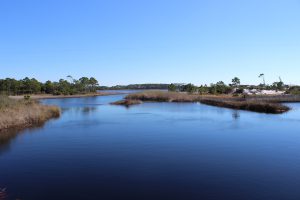
One of the many “jewels of south Walton” – the dune lakes.
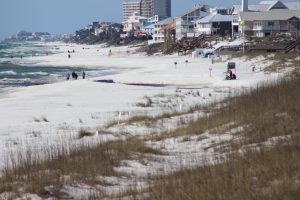
In the distance you can see the brown-tannic water of a dune lake entering the Gulf of Mexico.
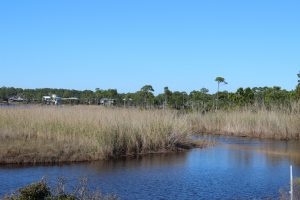
Black Needlerush is one of the species of marsh grasses that live in brackish conditions.
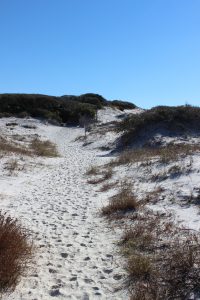
Dune trail at Grayton Beach State Park
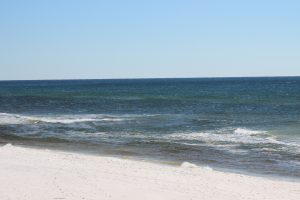
The Gulf of Mexico in south Walton County.
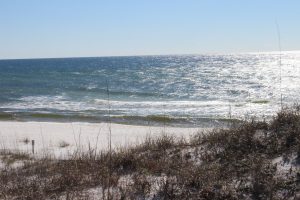
Another view of the Gulf of Mexico.
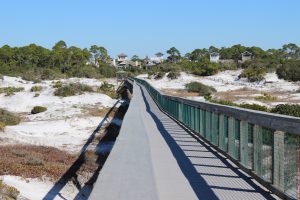
The boardwalk of Deer Lake State Park off of Highway 30-A. you can see the tracks of several types of mammals who pass under at night.
There are additional state park and state forest trail heads along 30A to explore. Accommodations are hard to come by during peak season so you will have to plan ahead – but a few days here is worth it.
If visiting the Escambia / Santa Rosa area be sure to check out the Naturally EscaRosa website and download the app to find great outdoor adventures in the western panhandle.
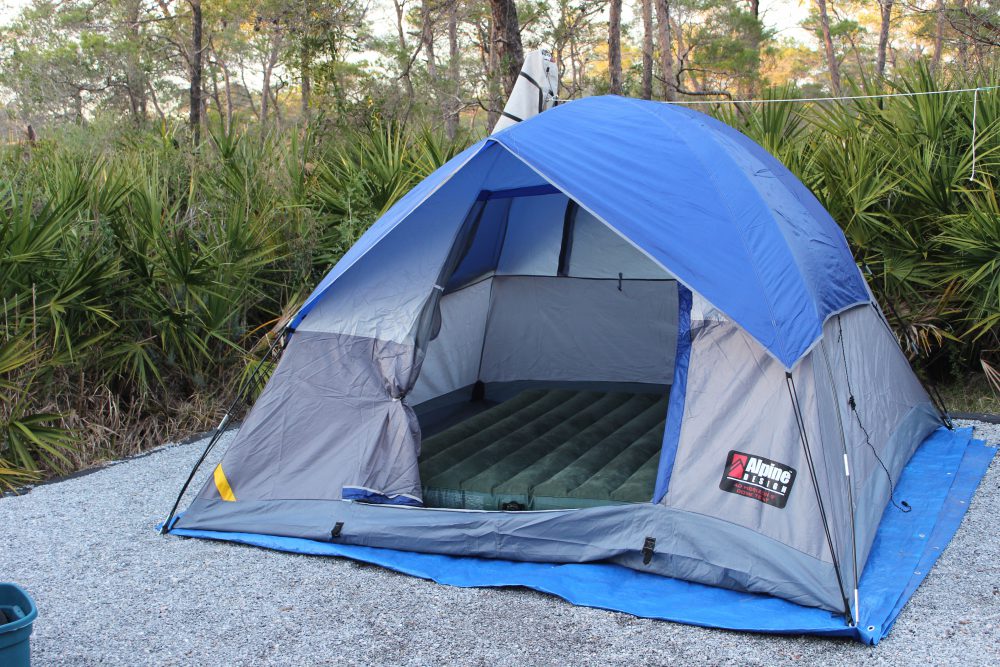
by Rick O'Connor | May 22, 2016
ALL PHOTOS: MOLLY O’CONNOR
Continuing our “ecotour” of the Florida Panhandle along the ICW, this month’s stop is in Walton County. Arguably one of the fastest growing counties in the state, South Walton has become a favorite with many. Relatively undeveloped (as compared to neighboring counties) Walton has an opportunity to develop smarter… and for a lot of it – they have.
Entering Walton County from the west you leave the concentrated tourism of Destin and enter Sandestin. Though still highly developed it slowly gives way to the Point Washington area and more open ground. Here you begin to encounter the famous Dune Lakes. There are no barrier islands along the coastline of Walton County. Instead the Gulf meets the peninsula separating it from Choctawhatchee Bay to the north. Along the Gulf there are magnificent dune fields and freshwater lakes that periodically are open to the Gulf. The lakes are unique in that they have freshwater habitats and tannic waters as well as saltmarsh and seawater when their “mouths” are open. This unique situation provides an ecosystem found in few places in our state. The now famous 30-A travels along these dune lakes across the entire of South Walton. Two state parks, a state forest, a bike trail, and small communities dot this famous trail.
Between 30-A and the Intracoastal Waterway to the north lies the Point Washington State Forest. Here lie acres of well managed pine forest. There are many trails that can be hiked, driven, or traversed by horseback. There are several trails here that are part of state forest’s Trailwalker Program. A major part of this well managed forest is prescribed burning.

This dune lake at Topsail State Park is one of many “stretched” across South Walton County.
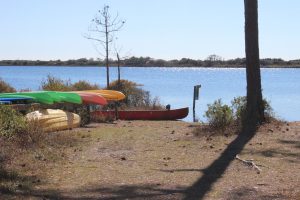
The state park provides kayaks for exploring the dune lake at Topsail. It can be reached by hiking or a tram they provide.
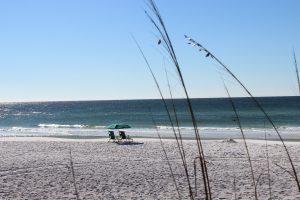
The beautiful beaches of south Walton.
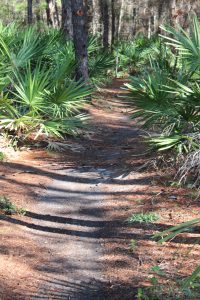
Here is one of the many state forest trails used by hikers and joggers.
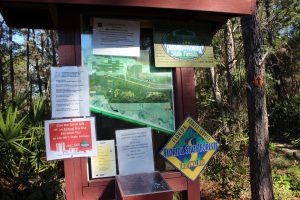
The Florida State Forest hiking trail system provides a lot of information about their trails that is very useful.
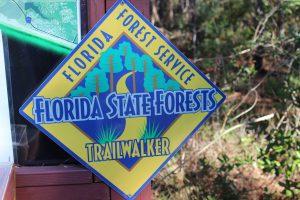
The Florida State Trailwalkers Program is a neat way to encourage locals to visit their “natural landscape”. You must hike 10 of the selected trails (on their website provided in this article). There is a log you can download and when you have logged your 10 hikes mail it in. You will receive a free patch indicating you are a “Florida Trailwalker”! This is a great way to explore your “natural Florida”.
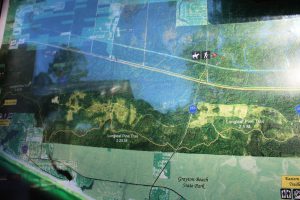
There are trails that cross Point Washington State Forest that can be driven, hiked, or even explored on horseback.
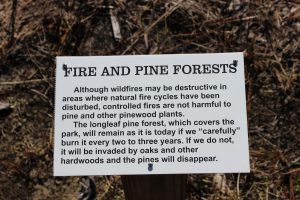
Signage educating the public about the benefits of prescribed burning.
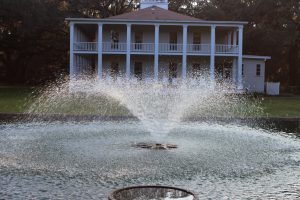
This is the renovated Wesley House at Eden Gardens State Park. The Wesley’s were in the timber industry.
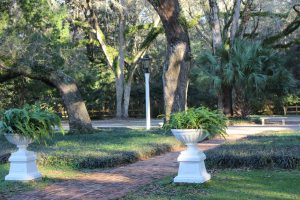
Eden Garden State Park is located north of Highway 98 in south Walton County. It borders the south side of the ICW near Choctawhatchee Bay and is a beautiful getaway.
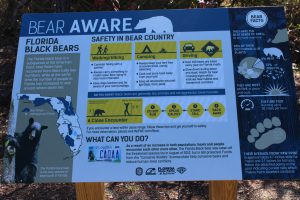
Partly due to successful bear management and partly due to the increase population of humans in the Florida panhandle, bear encounters are in the increase. This sign at Eden Garden State Park provides information on how to deal with an encounter.
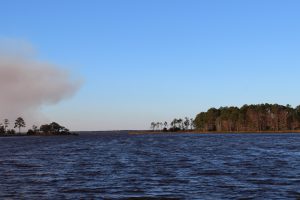
From Eden Garden State Park you can look across the bayou to the point where the ICW leaves Choctawhatchee Bay and enters a manmade canal locals refer to as “the ditch”. Notice the prescribed burn occurring across the bay.
PRESCRIBED BURNING
Now days many are aware of the forest management tool we call “prescribed burning”… but not all. For many people, fires are “wild” and the smoke they generate is an unwanted pain. Much of the southeast, particularly Florida, encounter thunderstorms with frequent lighting. These lighting strikes spark fires which burn across acres of forest. The frequency of the lighting storms – and fires – actually kept the understory below the pines cleared and so the fires typically burned low and slow. The result was an understory of grasses and wildflowers that supported a wide variety of species including deer and quail. When he traveled through the southeast in 1775, William Bartram described the longleaf forest as “open and monotonous – going on for miles”. And this was the case… you could literally see up to a mile across the landscape. But this “monotonous” landscape was misleading in that there were thousands of species found here – many feel one of the most biological diverse systems anywhere.
Today 90% of the longleaf has been logged and much of what remains is fire suppressed. For the reasons mentioned above, residents have resisted the natural burns and many species – gopher tortoises, quail, and indigo snakes to name three – have suffered as well. There is a move across the southeast to restore the old longleaf pine forest. These trees produce excellent timber – though it takes longer to grow than the loblolly and slash pine currently grown – and many are managing their property for quail and deer hunting. Yes… the smoke is a problem but the state forestry system plans their burns to reduce the impact it has on the local community as best they can. If you really want to see the benefits of a well-managed pine forest, take a hike through one – it truly is amazing.

by Rick O'Connor | Apr 22, 2016
ALL PHOTOS: MOLLY O’CONNOR
As many of you already know each month we have posted articles about nature tourism locations along the Intracoastal Waterway in the Florida Panhandle. This month we visit coastal Okaloosa County.
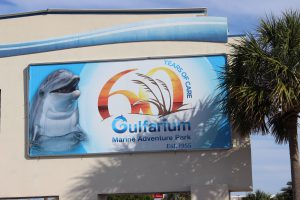
The Gulfarium in Ft. Walton Beach gives those who do not get a chance to go offshore, or dive, to see some of the unique marine organisms found in the Gulf of Mexico.
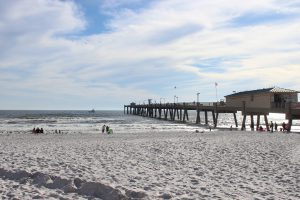
As with many other fishing piers along the panhandle, the Okaloosa Pier not only provides a spot for good fishing but a good spot to watch for marine life and great sunsets.
For years’ tourists have been visiting the beaches of Ft. Walton and Destin. The big draw has been the clean white sand but the area is also known for its really clear water. This clear water has supported a charter fleet that focuses on diving and fishing, but in recent years several operations have included inshore snorkeling and even trawling for marine life for tourists to view.
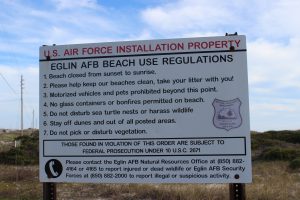
Many feel that you are not allowed on Eglin property. This is true for much of the island under their jurisdiction but there are places where you can park and enjoy the beach – though you must obey their rules.
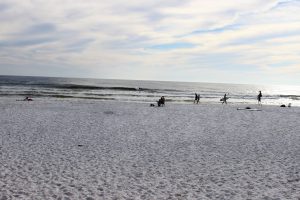
Residents enjoying the beach at one of the public access points on Eglin property.
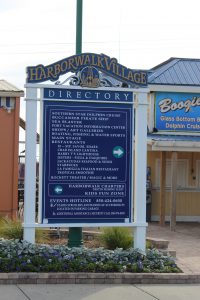
Destin harbor is now home the Haborwalk. There is a lot to see and do on the Haborwalk – and plenty of boat tours.
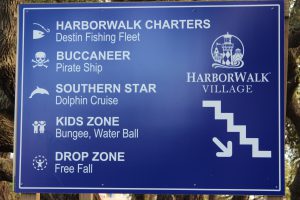
This sign gives the visitor some idea of the different activities that can be found along the Haborwalk.
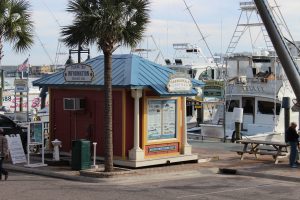
There are numerous types of tours to found along the Harborwalk. Information booths such as this one can help you find what you are looking for.
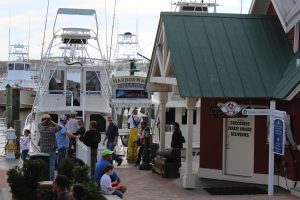
Charters include fishing, diving, snorkeling, and some collect marine life for you to see.
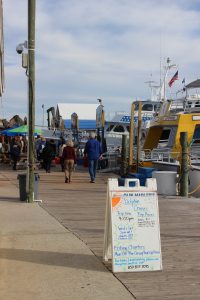
Dolphin cruises are very popular.
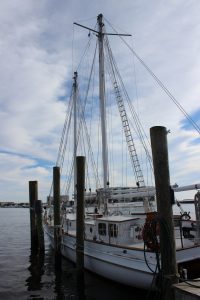
There are sailing charters that will allow you to experience the Gulf of Mexico, sunset cruises, and there are some designed with kids in mind.
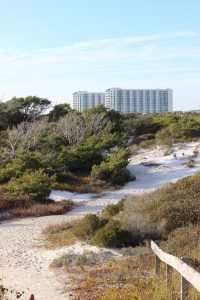
Henderson State Park is on the south side of Highway 98. It has hiking trails, a campground, and access to the Gulf. This is a nice natural location within a very urban area.
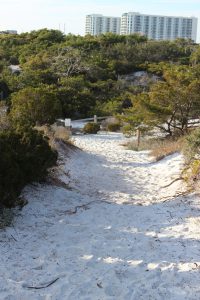
One of the scenic trails where you can explore the natural dune ecosystem in Henderson State Park
ARTIFICIAL REEFS
The natural substrate for most of the northern Gulf of Mexico is quartz sand. There are areas of hard bottom, shell hash, and even some natural reefs but sand dominates the landscape beneath the waves. There is no question that the natural coral reefs of the Florida Keys have been a huge economic engine for that part of the state. The clear, high saline water is filtered by the Everglades and allows much needed light to reach the tiny coral polyps and their symbiotic plant partners, which in turn produce limestone substrate for the polyp colonies to live and grow on.
Locally we have rivers that discharge into the Gulf but the water clarity is still pretty good. The bigger problem for coral development here is the cold winter temperatures and the lack of hard substrate for coral colonies to attach. There are several species of corals, and other encrusting invertebrates and plants, that can tolerate our cooler winters but substrate is still an issue. The answer… artificial substrate… artificial reefs.
Northwest Florida and Alabama have one of the most active artificial reef programs anywhere. Thousands of structures from small concrete pyramids, to chicken coops, to U.S. Navy vessels have been dropped to the bottom. The concept is “build it… and they will come” – meaning the encrusting organisms and eventually larger predatory fishes. At first artificial reefs were just left over rubble and car bodies that were indiscriminately dropped on the Gulf floor. But over years’ marine scientists began to monitor and evaluate what works and what does not and artificial reefs became a science. One question has not been answered… do artificial reefs generate more fish for fishermen – or do they just congregate the existing number of fish into more easily accessible points in the Gulf for easy capture? There is science that supports both arguments… and the debate continues. But if you want to know whether artificial reefs have been an economic success the answer is… yes… by the tens of millions of dollars it has. The charter fleets of Ft. Walton, Destin, Panama City, and Pensacola have all benefited from the artificial reef program. There are numerous structures to dive and many are part of the Florida Panhandle Shipwreck Trail.
If you get a chance take a charter and dive, or fish, one of these interesting and well thought out habitats. Next month we head further east to Walton County and the famous “30A” highway.











































